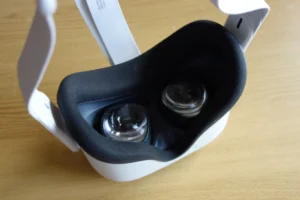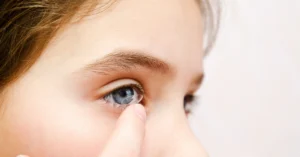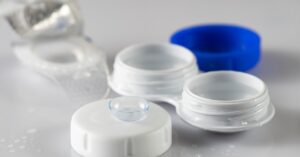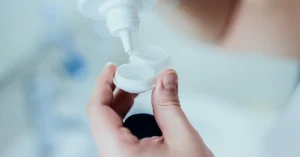Understanding Scleral Contact Lenses
Scleral contact lenses are a type of specialized contact lens that offer unique benefits for those with specific eye conditions. Let’s explore what scleral contact lenses are, who can benefit from them, and why they are a popular choice.
What are Scleral Contact Lenses?
Scleral contact lenses are larger in diameter compared to traditional contact lenses, covering not only the cornea but also the sclera (the white part of the eye). These lenses are designed to vault over the cornea, creating a tear-filled space between the lens and the corneal surface. This space helps to provide comfort, improve vision, and protect the cornea.
Due to their larger size, scleral lenses are more stable on the eye and less likely to move or dislodge during activities. The lenses are custom-made to fit each individual eye, ensuring a proper fit and optimal vision correction. The shape and design of scleral lenses make them suitable for various eye conditions.
Who Can Benefit from Scleral Contact Lenses?
Scleral contact lenses are particularly beneficial for individuals with certain eye conditions, including:
- Keratoconus: Scleral lenses can help correct vision in individuals with keratoconus, a condition where the cornea becomes thin and bulges outward. The lenses provide a smooth and regular surface for light to enter the eye, improving vision.
- Extreme Dry Eyes: Scleral lenses can provide relief for individuals with severe dry eyes. The tear-filled space between the lens and the cornea acts as a reservoir of moisture, keeping the eyes lubricated and reducing discomfort.
- Post Radial Keratotomy (RK) Surgery: Scleral lenses can be beneficial for individuals who have undergone RK surgery. These lenses can help improve vision by providing a stable and clear optical surface over the cornea, compensating for any irregularities caused by the surgical procedure.
Why Choose Scleral Contact Lenses?
Scleral contact lenses offer several advantages that make them an attractive option for those with specific eye conditions. Here are some reasons why individuals choose scleral contact lenses:
- Improved Comfort: The tear-filled space created by the lenses provides a cushioning effect and prevents the lenses from directly touching the sensitive cornea. This can result in enhanced comfort, especially for individuals with dry eyes or corneal irregularities.
- Superior Vision Correction: Scleral lenses offer excellent vision correction, providing clear and crisp vision. The larger lens design ensures stability on the eye, minimizing vision disturbances caused by lens movement.
- Protection and Healing: Scleral lenses can protect the cornea from further damage and aid in the healing process for certain eye conditions. The tear-filled reservoir acts as a barrier between the cornea and the environment, promoting healing and reducing the risk of complications.
- Longer Wear Time: Due to their larger size and design, scleral lenses can be worn for extended periods without discomfort. The tear reservoir provides a constant source of moisture, allowing for extended wear time.
Scleral contact lenses can be a game-changer for individuals with specific eye conditions, offering improved vision, comfort, and protection. If you think scleral lenses may be suitable for you, consult with a professional optometrist who specializes in fitting these lenses. They will guide you through the fitting process and ensure that you receive the best possible vision correction for your unique needs.
The Importance of Proper Fitting
When it comes to scleral lens fitting, the expertise of a professional optometrist is crucial in ensuring optimal vision and comfort. Proper fitting plays a significant role in the success and effectiveness of scleral contact lenses for patients with conditions such as keratoconus, extreme dry eyes, and those recovering from radial keratotomy (RK) surgery.
The Role of a Professional Optometrist
A professional optometrist specializes in fitting and prescribing contact lenses, including scleral lenses. They have the necessary knowledge and experience to assess your unique eye shape, size, and condition. Optometrists work closely with patients to determine the best design, material, and fit of scleral lenses that will address their specific needs.
During the fitting process, the optometrist performs various measurements and evaluations to ensure the lenses fit properly and provide optimal vision correction. They take into account factors such as the corneal shape, tear film stability, and any specific vision abnormalities. By collaborating with a professional optometrist, patients can have confidence that their scleral lenses will be tailored to their individual requirements.
The Process of Scleral Lens Fitting
Scleral lens fitting involves several steps to ensure the lenses fit comfortably and provide optimal vision correction. The process typically includes:
- Baseline Examination: The optometrist conducts a comprehensive eye examination to assess the overall health of your eyes and determine if you are a suitable candidate for scleral lenses.
- Corneal Topography: Corneal topography is used to map the surface of your cornea, providing valuable information about its shape, irregularities, and curvature. This helps in designing the lenses that will provide a proper fit.
- Trial Lens Fitting: The optometrist uses trial lenses to evaluate the fit and vision correction provided by the scleral lenses. This involves inserting different trial lenses and assessing their movement, alignment, and comfort on the eye.
- Refinements: Based on the initial trial lens fitting, the optometrist may make adjustments to the lens design or parameters to optimize the fit and vision correction. This may involve ordering custom-made lenses specific to your individual needs.
Factors Considered During Fitting
During the scleral lens fitting process, the optometrist considers several factors to ensure the best possible fit and comfort:
- Corneal Shape: The optometrist evaluates the shape of your cornea to determine the ideal lens design that will provide a proper fit without causing discomfort or compromising vision.
- Tear Film Stability: The stability and quality of your tear film are assessed to ensure the lenses will be adequately supported and remain lubricated throughout the day.
- Lens Diameter: The optometrist selects an appropriate lens diameter based on the size and shape of your eye to achieve a comfortable fit and proper alignment.
- Lens Material: The optometrist considers the material of the lenses based on your individual needs, such as oxygen permeability, durability, and any specific requirements for managing conditions like dry eyes.
By taking these factors into account, a professional optometrist can ensure that your scleral lenses provide the best possible fit, vision correction, and overall comfort. Regular check-ups and follow-ups with your optometrist are essential to monitor the effectiveness of the lenses and make any necessary adjustments. For more information on scleral lenses and related topics, check out our articles on scleral contact lenses and scleral lenses for dry eye.
Achieving Improved Vision with Scleral Lenses
Scleral lenses have gained popularity in the field of optometry due to their ability to provide improved vision for individuals with various vision abnormalities. Let’s explore how these lenses can help in correcting vision abnormalities, managing keratoconus, treating extreme dry eyes, and post radial keratotomy (RK) surgery.
Correcting Vision Abnormalities
Scleral lenses can effectively correct a wide range of vision abnormalities, including astigmatism, nearsightedness, and farsightedness. The unique design of these lenses, which vaults over the cornea and rests on the sclera (the white part of the eye), allows for a more precise and accurate refractive correction. By providing a smooth and even refractive surface, scleral lenses can significantly improve visual acuity and clarity for individuals with these vision abnormalities.
Managing Keratoconus
Keratoconus is a progressive eye condition characterized by thinning and bulging of the cornea, resulting in distorted vision. Scleral lenses are often a preferred choice for managing keratoconus due to their ability to create a stable and regular surface on the eye, improving vision and reducing the associated visual distortions. The rigid nature of these lenses helps to provide support to the cornea and maintain its shape, allowing for clearer and more comfortable vision.
Treating Extreme Dry Eyes
Individuals with extreme dry eyes often experience discomfort, blurry vision, and sensitivity to light. Scleral lenses can provide relief by acting as a protective reservoir for the eyes. These lenses are filled with a preservative-free saline solution or artificial tears, which continuously bathe the cornea, providing lubrication and moisture throughout the day. By keeping the cornea hydrated, scleral lenses can alleviate dry eye symptoms and improve visual acuity.
Post Radial Keratotomy (RK) Surgery
For individuals who have undergone radial keratotomy (RK) surgery, scleral lenses can be a valuable solution for vision correction. RK surgery involves creating incisions in the cornea to correct nearsightedness. However, this procedure can lead to irregular corneal shape and fluctuations in vision. Scleral lenses can provide a stable and smooth optical surface, compensating for the irregularities caused by RK surgery. This allows for improved vision and enhanced visual acuity post-surgery.
Scleral lenses offer a versatile and effective solution for individuals with various vision abnormalities, including keratoconus, extreme dry eyes, and post RK surgery. By working closely with a professional optometrist, patients can undergo a scleral lens fitting process to determine the most suitable lens design and parameters for their specific needs. Regular check-ups and maintenance, along with proper care and cleaning, ensure long-term comfort and optimal vision with scleral lenses.
Caring for Scleral Contact Lenses
Once you have been fitted with scleral contact lenses, proper care and maintenance are essential to ensure optimal vision and maintain the health of your eyes. This section will guide you through the necessary steps for cleaning and disinfecting, inserting and removing, and the importance of regular check-ups and maintenance.
Cleaning and Disinfecting
Keeping your scleral contact lenses clean is crucial to prevent the buildup of debris and bacteria, which can lead to discomfort and potential eye infections. Follow these steps to clean and disinfect your lenses:
- Wash your hands thoroughly with soap and water before handling your lenses.
- Remove your lenses from your eyes and place them in the palm of your hand.
- Apply a few drops of preservative-free saline solution or a recommended scleral lens cleaning solution to each lens.
- Gently rub each lens with your fingertip to remove any debris or deposits.
- Rinse the lenses thoroughly with saline solution to remove any cleaning solution residue.
- Place the lenses in a clean lens case and fill it with fresh saline solution or disinfecting solution recommended by your optometrist.
- Allow the lenses to soak for the recommended amount of time.
- Before reinserting the lenses, rinse them with saline solution to remove any remaining disinfecting solution.
It’s important to follow the specific cleaning and disinfection instructions provided by your optometrist or the lens manufacturer. Avoid using tap water or saliva to clean or store your lenses, as this can introduce harmful microorganisms.
Inserting and Removing
Proper technique for inserting and removing scleral contact lenses is essential to prevent damage to the lenses and injury to your eyes. Follow these steps for safe and effective lens insertion and removal:
Inserting Scleral Contact Lenses:
- Wash your hands thoroughly with soap and water.
- Fill the bowl of the lens with the recommended saline solution or artificial tears.
- Tilt your head slightly back and look straight ahead.
- Use one hand to hold your upper eyelid gently upward.
- Use the other hand to hold the lens on the pad of your index finger, concave side up.
- Place the lens on your eye and look downward into the lens.
- Slowly release your eyelid and blink a few times to center the lens.
Removing Scleral Contact Lenses:
- Wash your hands thoroughly with soap and water.
- Look straight ahead and pull down your lower eyelid.
- Place your index finger on the lower edge of the lens.
- Gently slide the lens downward onto the white of your eye.
- Pinch the lens between your thumb and index finger to remove it completely.
If you experience any difficulties or discomfort while inserting or removing your lenses, contact your optometrist for guidance. They can provide personalized instruction and address any concerns you may have.
Regular Check-ups and Maintenance
Regular check-ups with your optometrist are crucial to ensure the continued success of your scleral contact lenses. During these appointments, your optometrist will assess the fit of your lenses, evaluate your eye health, and make any necessary adjustments.
Additionally, it’s important to follow the maintenance schedule recommended by your optometrist. This may include periodic replacement of your lenses, lens case, and cleaning solutions. Adhering to these recommendations will help maintain the quality and effectiveness of your lenses.
By following the proper care and maintenance guidelines for your scleral contact lenses, you can enjoy clear vision and comfortable wear. Remember to always consult with your optometrist for personalized advice and recommendations.






















